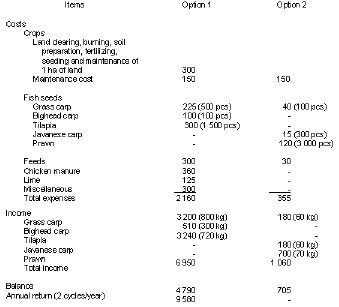


In Malaysia, integrated farming systems (Figure 1) have been practiced since the 1930s, with the production of fish in paddy fields and pig-fish in ponds. Although research shows that these systems are technically feasible and economically viable, socioeconomic factors, such as consumer preference, adoption by farmers, etc., need to be considered. Fodder-fish integration is one widely accepted system.
 |
 |
In the Third Malaysian Plan, fish culture is being promoted in a larger scope. Subsidies are given by the government for pond construction. Fish seed supply is provided as well as training and exten-sion. This system benefits family consumption by providing enough supply of protein. Moreover, it can be a source of additional income.
The fodder-fish integration (Figure 2) utilizes the most commonly used fodder species as fish feeds (Figure 3). These are: napier grass (Pennisetum purpureum), cassava (Manihot esculenta) and ipil-ipil (Leucaena leucocephala).



1. Weed the land.
2. Plant fodder crops.
3. Management care
4. Harvest the fodder.
5. Feed preparation
1. Pond design
The pond (0.1-0.5 ha in size) should be established near water sources and should be free from flood or drought.
Bunds are built to separate the ponds. Bunds should be between 2 and 3 m and capable of holding a water depth of 1 m. Water is supplied through gravity flow. Screened inlet and output pipes are installed.
A feeding area within the pond is constructed (located at the side). Bamboo poles or trunks of trees can be used.
There are two types of pond:
 |
 |
 |
 |
2. Pond preparation and system establishment
- temperature = 22-32°C
- early morning oxygen = 3 mg/litre
- pH = 6.5-8.3
Option 1: Grass carp is cultured in the nursery pond. After 4-6 months, the fish are transferred to the growout pond with the bighead carp and tilapia.
Option 2: Fish and prawn can be stocked directly to the growout pond.
- Check the pond for leaks.
- Clean filters.
 |
 |
 |
If the fish are at the pond surface, feeds are needed. If they are gasping at the surface or the prawn are in the periphery of the pond, aeration is needed. Aerate the pond by stirring the water with a tree branch. Suspend fertilizer additions and later resume with reduced rates.
Also, watch for predators.
- Feed the fish/prawn.
Option 1: After the pond is fertilized, introduce duckweeds. Grass carp feed on duckweeds for the first month. Then, give chopped cassava leaves and napier grass. Feeding is twice a day (morning and afternoon).
Upon transfer into the growout pond, feed the fish with grass and cassava leaves (200 kg/day). For tilapia, cooked maize, food leftovers and chopped cassava are given. The amount depends on the fish behaviour. If the fish are still in the feeding area, more feeds are needed.
 |
 |
 |
 |
 |
Option 2: At the start, feed the fish four times a day. Give rice bran, bread, chopped sago, cassava and napier grass.
For the fish, give feeds inside the feeding area. For the prawn, broadcast the feeds all over the pond. If there are still feeds found in the water, stop feeding.
- Check the pond walls and bottom. Remove any debris which might be a problem at harvest time, e.g. twigs, leaves, etc.
- Check the fertility and turbidity of the water by dipping your arm into the water. If the palm disappears before the water reaches the elbow, there is dense algal bloom.
- Check the fish carefully for any sign of disease.
 |
 |
 |
3. Potentials
4. Limitations
Budget (in M$) for fodder-fish integration for 1 ha pond

1992: US$1 = M$2.70